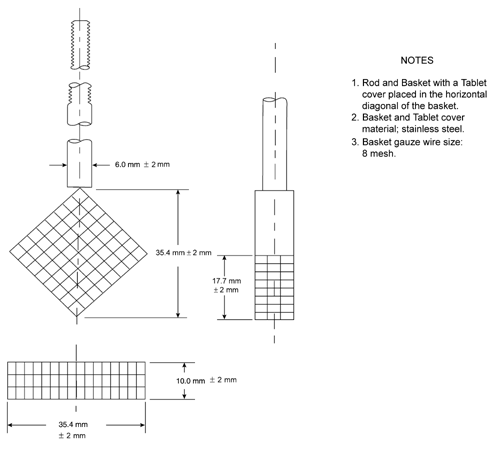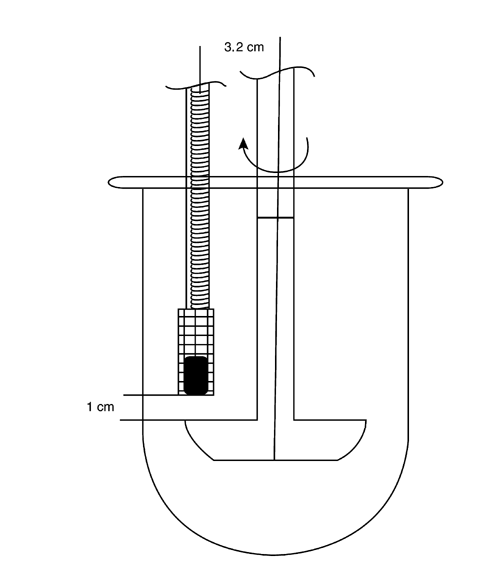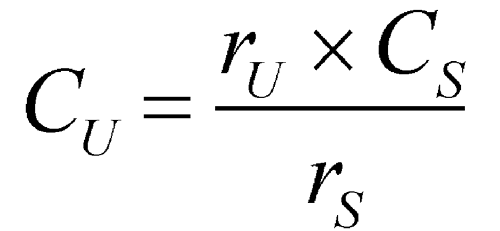Felodipine Extended-Release Tablets
» Felodipine Extended-Release Tablets contain not less than 90.0 percent and not more than 110.0 percent of the labeled amount of felodipine (C18H19Cl2NO4).
Packaging and storage—
Preserve in tight containers.
Labeling—
When more than one test for Dissolution is given, the Labeling section states the test for Dissolution used only if Test 1 is not used.
Identification—
The retention time of the major peak in the chromatogram of the Assay preparation corresponds to that in the chromatogram of the Standard preparation, as obtained in the Assay.
Dissolution  711
711 —
—
test 1—
Medium:
pH 6.5 phosphate buffer with 1% sodium lauryl sulfate; 500 mL. (Medium is prepared as follows. Transfer 206 mL of 1 M monobasic sodium phosphate monohydrate, 196 mL of 0.5 M dibasic sodium phosphate anhydrous, and 50.0 g of sodium lauryl sulfate to a 5000-mL volumetric flask. Add approximately 4000 mL of water, and mix well. If necessary, adjust with 1 N sodium hydroxide to a pH of 6.5. Dilute with water to volume, and mix well.)
Apparatus 2:
50 rpm.
Times:
2, 6, and 10 hours.
Buffer solution—
Prepare as directed in the Assay.
Mobile phase—
Prepare a filtered and degassed mixture of acetonitrile, Buffer solution, and methanol (2.5:2:1). Make adjustments if necessary (see System Suitability under Chromatography  621
621 ).
).
Standard stock solution—
Dissolve an accurately weighed quantity of USP Felodipine RS in alcohol to obtain a solution having a known concentration of 0.25 mg per mL.
Standard solution—
Dilute an accurately measured volume of the Standard stock solution quantitatively, and stepwise if necessary, with Medium to obtain a solution having a known concentration of USP Felodipine RS equivalent to the concentration that would result from about 60% dissolution of a single Tablet in 500 mL of Medium.
Test solution—
Place each Tablet in a specially made quadrangular basket of stainless steel wire gauze, soldered in one of its upper, narrow sides to the end of a steel rod (see Figure 1). Place the tablet cover in the horizontal diagonal of the basket. Put the rod assembly up through the cover of the dissolution vessel, and fix it by means of two teflon nuts, 3.2 cm from the center of the vessel, or by any other appropriate means. Adjust the lower edge of the bottom of the basket to approximately 1 cm above the top of the paddle blade (see Figure 2). Orient the large side of the basket tangentially to the flow stream with the Tablet standing on its edge. Pass a 10-mL portion of the solution under test, obtained at each time interval, through a suitable filter.
Chromatographic system—
Proceed as directed in the Assay.
Procedure—
Separately inject equal volumes (100 µL) of the Standard solution and the Test solution into the chromatograph, record the chromatograms, and measure the areas for the major peaks. Calculate the quantity, in mg, of felodipine (C18H19Cl2NO4) dissolved in the Medium by the formula:
CD(rU / rS)
in which C is the concentration, in mg per mL, of USP Felodipine RS in the Standard solution; D is the dilution factor used in preparing the Test solution; and rU and rS are the felodipine peak areas obtained from the Test solution and the Standard solution, respectively.
Tolerances—
The percentages of the labeled amount of C18H19Cl2NO4 dissolved at the times specified conform to Acceptance Table 2.
| Time (hours) | |
| 2 | between 10% and 30% |
| 6 | between 42% and 68% |
| 10 | not less than 75% |
test 2—
Medium:
1% (w/v) polysorbate 80 in water; 500 mL.
Apparatus 1:
100 rpm.
Times:
1, 4, and 8 hours.
Determine the amount of C18H19Cl2NO4 dissolved by employing the following method.
Buffer solution—
Transfer 6.9 g, accurately weighed, of monobasic sodium phosphate into a 1-L volumetric flask containing about 400 mL of water. Add 8.0 mL of 1 M phosphoric acid, dilute with water to volume, and mix.
Mobile phase—
Prepare a filtered and degassed mixture of Buffer solution, acetonitrile, and methanol (2:2:1). Make adjustments if necessary (see System Suitability under Chromatography  621
621 ).
).
Standard stock solution—
Transfer 40 mg, accurately weighed, of USP Felodipine RS into a 200-mL volumetric flask, add about 200 mL of methanol. Sonicate for 2 minutes, cool, dilute with methanol to volume, and mix.
Standard working solutions—
Transfer the appropriate volume of Standard stock solution into a suitable volumetric flask according to the following table.
Dilute with Medium to volume, and mix.
| Tablet Label Claim (mg) |
Volume Transferred (mL) |
Volumetric Flask (mL) |
| 10 | 10 | 100 |
| 5 | 5 | 100 |
| 2.5 | 2.5 | 100 |
Test solution—
Pass a portion of the solution under test through a suitable 0.45-µm filter. Replace the withdrawn amount with Medium.
Chromatographic system (see Chromatography  621
621 )—
The liquid chromatograph is equipped with a 254-nm detector and a 4.6-mm × 15-cm column that contains packing L1. The flow rate is about 1 mL per minute. Chromatograph the Standard working solution, and record the peak responses as directed for Procedure: the capacity factor (k ¢) is not less than 5, the column efficiency (N) is not less than 1500 theoretical plates, the tailing factor is not more than 1.5, and the relative standard deviation for replicate injections is not more than 2.0%.
)—
The liquid chromatograph is equipped with a 254-nm detector and a 4.6-mm × 15-cm column that contains packing L1. The flow rate is about 1 mL per minute. Chromatograph the Standard working solution, and record the peak responses as directed for Procedure: the capacity factor (k ¢) is not less than 5, the column efficiency (N) is not less than 1500 theoretical plates, the tailing factor is not more than 1.5, and the relative standard deviation for replicate injections is not more than 2.0%.
Procedure—
Separately inject equal volumes (about 20 µL) of the Standard working solution and the Test solution into the chromatograph, record the chromatograms, and measure the peak responses. Calculate the quantity, in mg, of felodipine (C18H19Cl2NO4) dissolved by the formula:
in which CU is the concentration, in mg per mL, of felodipine in the sample at each time point; rU and rS are the peak responses obtained from the Test solution and the Standard working solution, respectively; and CS is the concentration, in mg per mL, of felodipine in the Standard working solution.
Calculate the amount, in percentage, of felodipine (C18H19Cl2NO4) dissolved, with volume correction, by the formula:
in which CN is the concentration, in mg per mL, of felodipine in the Test solution at each time point; 500 is the volume, in mL, of Medium; VU is the volume, in mL, of sample withdrawn at each time point; n is the time point (at 4 hours, n + 1), summation of the concentration of the Test solution from the first to the (n – 1)th time point (only applicable for n = 2); 100 is the conversion factor to percentage; and LC is the tablet label claim, in mg.
Tolerances—
The percentages of the labeled amount of felodipine dissolved at the times specified conform to Acceptance Table 1.
| Time (hours) | |
| 1 | between 5% and 30% |
| 4 | between 45% and 70% |
| 8 | not less than 80% |
Uniformity of dosage units  905
905 :
meet the requirements.
:
meet the requirements.
procedure for content uniformity—
Buffer solution, Mobile phase, Standard stock preparation, and Chromatographic system—
Proceed as directed in the Assay.
Standard solution—
Use the Standard preparation, prepared as directed in the Assay.
Test solution—
Transfer 1 Tablet to a 100-mL volumetric flask, add 40 mL of acetonitrile, and sonicate for 20 minutes with occasional swirling. Add 20 mL of methanol, and shake by mechanical means for 30 minutes. Allow to cool to room temperature, dilute with Buffer solution to volume, and mix. Centrifuge a portion of the solution at high speed for 15 minutes. Dilute a portion of the supernatant with Mobile phase to obtain a solution containing about 20 µg of felodipine per mL. Pass this solution through a filter having a 0.5-µm or finer porosity.
Procedure—
Separately inject equal volumes (about 40 µL) of the Standard solution and the Test solution into the chromatograph, record the chromatograms, and measure the responses for the major peaks. Calculate the quantity, in mg, of felodipine (C18H19Cl2NO4) in the Tablet taken by the formula:
(TC/D)(rU / rS)
in which T is the labeled quantity, in mg, of felodipine in the Tablet; C is the concentration, in µg per mL, of USP Felodipine RS in the Standard solution; D is the concentration, in µg per mL, of felodipine in the Test solution, based on the labeled quantity per Tablet and the extent of dilution; and rU and rS are the felodipine peak responses obtained from the Test solution and the Standard solution, respectively.
Related compounds—
Buffer solution and Mobile phase—
Prepare as directed in the Assay.
Standard stock solution 1—
Dissolve an accurately weighed quantity of USP Felodipine Related Compound A RS in methanol to obtain a solution having a known concentration of about 0.2 mg per mL. Transfer 10.0 mL of this solution to a 100-mL volumetric flask, dilute with Mobile phase to volume, and mix.
Standard stock solution 2—
Dissolve an accurately weighed quantity of USP Felodipine RS in methanol, and dilute quantitatively, and stepwise if necessary, with methanol to obtain a solution having a known concentration of about 2 mg per mL.
System suitability solution—
Transfer 15.0 mL of Standard stock solution 1 and 5.0 mL of Standard stock solution 2 to a 100-mL volumetric flask, dilute with Mobile phase to volume, and mix.
Standard solution—
Transfer 10.0 mL of Standard stock solution 1 to a 100-mL volumetric flask, dilute with Mobile phase to volume, and mix.
Test solution—
Proceed as directed for the Assay preparation in the Assay, except that after centrifuging a portion of the solution at high speed for 15 minutes, pass a portion of the supernatant through a filter having a 0.5-µm or finer porosity, discarding the first 4 mL of the filtrate.
Chromatographic system (see Chromatography  621
621 )—
The liquid chromatograph is equipped with a 254-nm detector and a 4.6-mm × 15-cm column that contains packing L1. The flow rate is about 1 mL per minute. Chromatograph the System suitability solution, and record the peak responses as directed for Procedure: the relative retention times are 0.75 for felodipine related compound A and 1.0 for felodipine; the resolution, R, between felodipine and felodipine related compound A is not less than 1.5; and the column efficiency is not less than 1500 theoretical plates.
)—
The liquid chromatograph is equipped with a 254-nm detector and a 4.6-mm × 15-cm column that contains packing L1. The flow rate is about 1 mL per minute. Chromatograph the System suitability solution, and record the peak responses as directed for Procedure: the relative retention times are 0.75 for felodipine related compound A and 1.0 for felodipine; the resolution, R, between felodipine and felodipine related compound A is not less than 1.5; and the column efficiency is not less than 1500 theoretical plates.
Procedure—
Separately inject equal volumes (about 40 µL) of the Standard solution and the Test solution into the chromatograph, record the chromatograms, and measure the peak responses for felodipine related compound A. Calculate the percentage of felodipine related compound A in the portion of Tablets taken by the formula:
1000C(rU / rS)
in which C is the concentration, in mg per mL, of USP Felodipine Related Compound A RS in the Standard solution; and rU and rS are the peak responses of felodipine related compound A obtained from the Test solution and the Standard solution, respectively: not more than 2.0% is found.
Assay—
Buffer solution—
Dissolve 6.9 g of monobasic sodium phosphate in about 800 mL of water in a 1000-mL volumetric flask. Adjust with 1 M phosphoric acid to a pH of 3.0 ± 0.05, dilute with water to volume, and mix.
Mobile phase—
Prepare a filtered and degassed mixture of Buffer solution, acetonitrile, and methanol (2:2:1). Make adjustments if necessary (see System Suitability under Chromatography  621
621 ).
).
Standard stock preparation—
Dissolve an accurately weighed quantity of USP Felodipine RS in methanol, and dilute quantitatively, and stepwise if necessary, with methanol to obtain a solution having a known concentration of about 2 mg per mL.
Standard preparation—
Dilute an accurately measured volume of the Standard stock preparation quantitatively and stepwise with Mobile phase to obtain a solution having a known concentration of about 0.02 mg per mL.
Assay preparation—
Weigh and finely powder not fewer than 10 Tablets. Transfer an accurately weighed portion of the powder, equivalent to about 10 mg of felodipine, to a 100-mL volumetric flask, add 40 mL of acetonitrile and 20 mL of methanol, and sonicate for 5 minutes. Add about 30 mL of Buffer solution, and shake by mechanical means for 30 minutes. Allow the solution to cool to room temperature, dilute with Buffer solution to volume, and mix. Centrifuge a portion of the solution at high speed for 15 minutes. Transfer 10 mL of the supernatant to a 50-mL volumetric flask, dilute with Mobile phase to volume, and mix. Pass a portion of this solution through a filter having a 0.5-µm or finer porosity, discarding the first 4 mL of the filtrate.
Chromatographic system (see Chromatography  621
621 )—
The liquid chromatograph is equipped with a 362-nm detector and a 4.6-mm × 15-cm column that contains packing L1. The flow rate is about 1 mL per minute. Chromatograph the Standard preparation, and record the peak responses as directed for Procedure: the column efficiency is not less than 1500 theoretical plates; and the relative standard deviation for replicate injections is not more than 2.0%.
)—
The liquid chromatograph is equipped with a 362-nm detector and a 4.6-mm × 15-cm column that contains packing L1. The flow rate is about 1 mL per minute. Chromatograph the Standard preparation, and record the peak responses as directed for Procedure: the column efficiency is not less than 1500 theoretical plates; and the relative standard deviation for replicate injections is not more than 2.0%.
Procedure—
Separately inject equal volumes (about 40 µL) of the Standard preparation and the Assay preparation into the chromatograph, record the chromatograms, and measure the responses for the major peaks. Calculate the quantity, in mg, of felodipine (C18H19Cl2NO4) in the portion of Tablets taken by the formula:
500C(rU / rS)
in which C is the concentration, in mg per mL, of USP Felodipine RS in the Standard preparation; and rU and rS are the peak responses obtained from the Assay preparation and the Standard preparation, respectively.
Auxiliary Information—
Please check for your question in the FAQs before contacting USP.
Chromatographic Column—
| Topic/Question | Contact | Expert Committee |
| Monograph | Sujatha Ramakrishna, Ph.D.
Scientist 1-301-816-8349 |
(MDCV05) Monograph Development-Cardiovascular |
| Reference Standards | Lili Wang, Technical Services Scientist 1-301-816-8129 RSTech@usp.org |
|
| Margareth R.C. Marques, Ph.D.
Senior Scientist 1-301-816-8106 |
(BPC05) Biopharmaceutics05 |
USP32–NF27 Page 2347
Pharmacopeial Forum: Volume No. 32(1) Page 89
Chromatographic columns text is not derived from, and not part of, USP 32 or NF 27.




